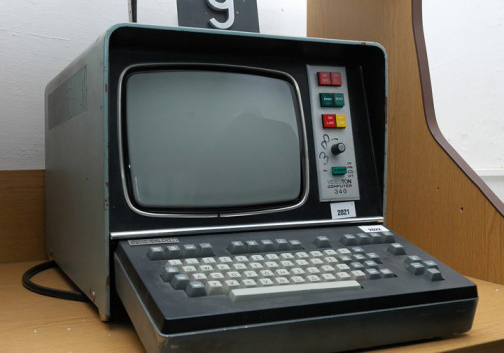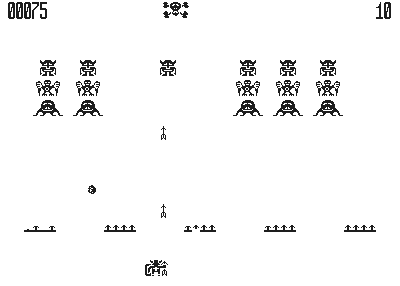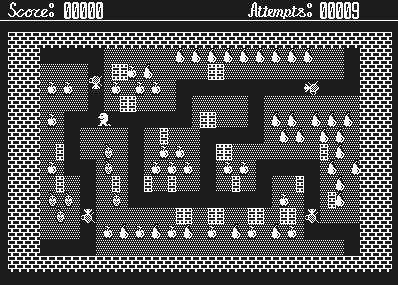Star Trek: 1971 text game

When Habré compiled a list of the best games of all times and peoples, in the comments several times slipped the idea that the topic turns into a list of the oldest games that can be remembered. And then I thought, what if I really try to remember the very first game I played?
Maybe I am mistaken, because it was almost 30 years ago, but it seems to me that this very first, and by the way, very good game for that time, was Star Trek . It is believed that the original version was created by Mike Mayfield in 1971, but I caught it in the mid-80s. Perhaps now the process of the game seems not so exciting as it was then, so I decided to write about it solely on the basis of the remaining memories, and with a little use of the source code.
I played it on the SM-3 , which had a very popular then terminal Videoton VT340, which had a black and white alphanumeric screen that displayed 16 lines of 80 characters each.
')

The game itself by genre is a text based step-by-step space simulator, so to speak. It was necessary for a limited time to destroy all the Klingon ships that are within the playing field of 8x8 quadrants, each of which is in turn divided into 8x8 sectors.
Destroy them with a phaser and photon torpedoes, the stock of which can be replenished on several bases scattered throughout the galaxy. A phaser can destroy several Klingons at once, especially if they are close, but it takes a lot of energy. Torpedoes destroy them one by one, and the energy is not spent on it, but you need to accurately aim. I remember that the speed at which the torpedo’s flight coordinates were displayed on the display was small, and it was possible to observe the process as if it was happening in real time.
The captain has a computer at his disposal that can calculate the course of the ship or torpedoes. However, he, like any other system, can be damaged in battle, and then the course will have to be considered yourself. Even greater difficulties arise if there is a star on the way, and you need to get to the right sector the first time, having rounded it, otherwise the Klingons will fire the ship when the turn passes to them. Here is an example of such a situation:

The computer does not take into account the obstacles, and to determine the correct course “by eye” so that the torpedo passes by the star, but gets into the Klingon, great skill is required. The directions were set in a very unusual way, in polar coordinates with an angle from 1 to 9. Those who played, certainly remember. Still in the game was a protective field that could be controlled.
From the time of creation to the end of the 80s there were a lot of different versions of the game. There were complicated options, with new types of objects and enemies. There were versions in BASIC, FORTRAN, KOBOL and other languages for almost all types of computers that existed then. The version I was playing was classic, only slightly modified and translated into Russian by someone. Now only a listing is preserved from it, printed out for transfer to the Radio86-compatible computer that appeared at about that time, so that it would be possible (just incredible!) To play at home.

As you can see, some needles are broken, and the printer used a two-color, red-black ribbon, which either due to a malfunction, or because it was not from that printer, partially colored the letters from the bottom in red.
Perhaps among the readers there are those who played this very version, or even those who translated it, here are some memorable phrases:
Messages from Russian Star Trek
Space Curvature Coefficient (0-8)
Ensign Zinin reports: "Wrong course, captain!"
Engines stalled in sector 1, 4! Navigation error
The scientist officer Grits reports: “instruments show the absence of enemy ships in this quadrant.”
150 energy units hit the ship from sector 6, 3
(protective field dropped to 562 units.)
*** Near-view locators are faulty ***
Technicians insist on repairing your ship
Estimated repair time: .4 star days
Do you allow repairs?
Ensign Zinin reports: "Wrong course, captain!"
Engines stalled in sector 1, 4! Navigation error
The scientist officer Grits reports: “instruments show the absence of enemy ships in this quadrant.”
150 energy units hit the ship from sector 6, 3
(protective field dropped to 562 units.)
*** Near-view locators are faulty ***
Technicians insist on repairing your ship
Estimated repair time: .4 star days
Do you allow repairs?
There were, of course, other games, but all alphanumeric, in addition, the video line spacing is quite large and not suitable for games. Most games were like Star Trek, step by step, but there were exceptions, for example, Tetris. Such games we called then “dynamic”. This meant that the action takes place constantly, without waiting for the player to respond from the keyboard.
And I also had a printout from the screen of an unknown graphic computer, located somewhere in an inaccessible place. As it turned out, and she remained in the closet so far:

I managed to remember the name of the game: “Sheriff”, thanks to which an article , written in 2012, about the creators of these games was found. Maybe someone will also remind the good old days, here are some screenshots from that article, taken from the emulator:
Hidden text
Pif-paf

Garden

Land


Garden

Land

In those days, graphic games seemed something incredible. One could only dream of the fact that they would once become colored. As I said, I could not play these games, and all I could do was look at the printout and imagine how it might look in motion.
But back with Star Trek'u. After writing the article, I decided to still try to play it. Using the listing, I found the version that is closest to the one I had in the 80s, and after a small correction, it started. I started to play, gradually getting used to the long-forgotten environment. When the next torpedo, despite the course calculated by the computer, suddenly flew in the wrong direction, I became suspicious. And when a little later the start of the engine ended with an error (going beyond the array boundaries), it became clear for good.
It turned out that in the version published in 1978 in the book 101 Games in BASIC , with which, apparently, all versions that went around the country were recruited, there was an error. When indexing an array to calculate the ship's course and torpedoes, the real value is rounded, although the author expected it to be truncated. These lines are visible on the scan of the page above.
3110 X1=C(C1,1)+(C(C1+1,1)-C(C1,1))*(C1-INT(C1)) 3140 X2=C(C1,2)+(C(C1+1,2)-C(C1,2))*(C1-INT(C1)) As a result, if the fractional part of a given course is greater than 0.5, the direction is not calculated correctly, and if it is greater than 8.5, an error occurs. 30 years ago we played like that. At first they thought that it was such a feature of the game that introduced additional difficulties, and then it was found and corrected, but I completely forgot about it. Interestingly, in the original version of 1972 this error was not.
I fixed the program and started the game again. Although there were surprises, everything went about as I remember from previous times. In a battle with three Klingons, the computer was damaged, and I honestly calculated the courses for torpedoes in my mind. At the most necessary moment, the engines broke down, I had to be dragged through several quadrants, losing time. Although before the start of the game I slightly increased the time allotted for the task, it quickly melted, and by the end of the flight of the galaxy I had only a few star days left.
When flying to the quadrant with the penultimate Klingon, the photon torpedoes broke, and the phaser had to be used. While I got to the last enemy, the launcher was repaired, but as an evil, there was a star in the line of fire, and the torpedo did not work. I had to spend the rest of the energy on the last phaser strike. The last battle cruiser of the Klingons destroyed, the federation saved! So after many years, another star battle successfully ended.
I wish good luck by wanting to return to the past, to Star Trek or another first game of yours, because finding it and making it work is no less interesting today than playing it.
Source: https://habr.com/ru/post/176125/
All Articles